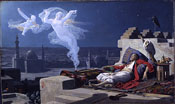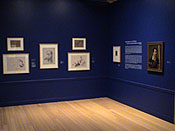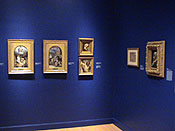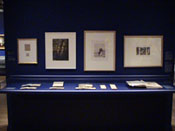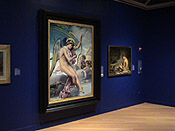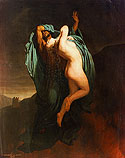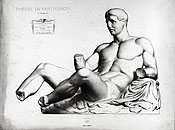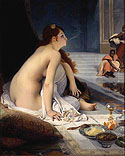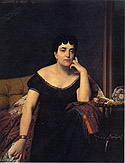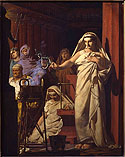The browser will either open the file, download it, or display a dialog.
|
"From Homer to the Harem: The Art of Jean Lecomte du Nouÿ" Roger Diederen |
||||||
|
The recent exhibition "From Homer to the Harem: The Art of Jean Lecomte du Nouÿ" at the Dahesh Museum of Art in New York provided a unique opportunity to revisit the work of this largely forgotten nineteenth-century French academic artist, who lived from 1842 until 1923, and was once a well-known orientalist, classicist, portraitist, and history painter. In a gathering of some 100 paintings, drawings, and lithographic reproductions, the Dahesh Museum presented the first posthumous retrospective devoted to Lecomte du Nouÿ on either side of the Atlantic. Despite the absence of two large religious altarpieces and a handful of lost works (notably The Bearers of Bad Tidings, 1871, location unknown), the exhibition did an admirable job of reconstructing the artist's career. In addition, it constituted another fascinating case study in the predicament and possibilities of historical interpretation confronting the Dahesh Museum as it pursues its stated mission "to place the work of Europe's academically trained artists in the broader context of 19th-century art and to offer a fresh appraisal of the role academies played in reinvigorating the classical ideals of beauty, humanism, and skill." Attractively displayed in the galleries, and meticulously documented in a colorfully illustrated, painstakingly researched catalogue authored by curator Roger Diederen, the oeuvre of Lecomte du Nouÿ enjoyed a kind of resurrection. Raised from historical oblivion, the artist's work came alive again briefly on the walls of the Dahesh—a temporary vision of elusive ideal beauty fraught with narcotic fantasy and colonial ambivalence, like the mirage of opium smoke wafting from a pipe in The Dream of a Eunuch, a signature orientalist painting by the artist featured on the catalogue cover.1 (fig. 1) | |||||
| In a predictable echo of nineteenth-century cultural politics (as well as the Jekyll and Hyde politics of our own time), reviewers of the exhibition have assessed Lecomte du Nouÿ as both an "extremely talented artist" and as "further evidence of the dead end that spurred the French modernist movement."2 Both positions have merit in their own limited ways, but the present review takes a third, less polemical path more in keeping with the museum's own balanced line of interpretation, while also highlighting certain interpretive omissions and opportunities that seem to have gone unnoticed by other reviewers as well as by the exhibition organizers themselves. As an Americanist used to approaching art history from a cultural studies perspective, I feel that Lecomte du Nouÿ's work invites exploration into avenues of historical interpretation that the partisans of connoisseurship and modernism generally ignore. In touching upon highlights of the exhibition and its accompanying catalogue, I will read Lecomte du Nouÿ's work as exemplifying the irruption of modernity (though not modernism) within late nineteenth-century academic art. | ||||||
| As with all exhibitions at the recently reopened Dahesh, From Homer to the Harem: The Art of Jean Lecomte du Nouÿ occupied the basement of the IBM Building at 590 Madison Avenue, an edifice constructed in 1983 in a rather Miesian late modernist design by architect Edward Larrabee Barnes, a Walter Gropius protégé who died coincidentally in 2004 after a long career committed to the ideals of the International Style.3 That location and context, necessitating passage through functionalist glass entry doors into the ornately orientalist museum shop before going downstairs to the galleries, makes its own telling statement about compromises demanded of the beau idéal in an era of corporate capitalism—compromises of the sort that arguably already informed Lecomte du Nouÿ's work in the late nineteenth century. With its reproduction taboret tables, imported Middle Eastern inlayed boxes, and other decorative objets, the shop provided an appropriate preview to the exhibition, in which pictorial representations of similar exotic wares often appeared (in orientalist works such as The Dream of a Eunuch, 1874, The Gate of the Harem, 1876, and The White Slave, 1888). Intentionally or not, the art of Lecomte du Nouÿ, and of the Dahesh itself, embody some of the very dynamic, expansive forces of modernity that they would seem at first glance to oppose. | ||||||
| Though clearly not an Impressionist or other artistic modernist, Lecomte du Nouÿ was certainly modern insofar as his work directly and indirectly broached some of the key issues of his day, albeit from a decidedly conservative perspective: colonialism, international trade, gender, religion, and history. To the extent that such issues remain firmly at the center of our cultural and political landscape today, (viz the recent American election and ongoing engagements in the Middle East) we can tentatively agree with the introductory wall text's assertion that the artist's work is "extraordinarily relevant" to our time. The precise artistic and ideological implications of that relevance were left unexamined, though. Could deeper analysis of Lecomte du Nouÿ's orientalist fantasies somehow help us unpack the significance of Abu Ghraib or the Darfur genocide? Do his ethnographic visions of Jewish orthodoxy hold a key to negotiating a two-state solution in Palestine? In a stricter artistic sense, does his work provide a model for twenty-first-century painters disgruntled by the growing hegemony of digital media? Or did Lecomte du Nouÿ actually anticipate the latter? The exhibition provided no direct answers to those questions, but it did hint at a useful historical interpretation. Framing Lecomte du Nouÿ's "contemporary relevance" in terms of both "story telling" and "visual power," the wall text thereby alerted us to the importance of distinguishing narrative from purely pictorial concerns when assessing the artist's work. It is precisely in the interstices between those concerns that we find the most interesting evidence of the artist's modernity. | ||||||
| Once downstairs and past the museum's permanent collection gallery (which includes two original paintings by Lecomte du Nouÿ's most revered master Jean-Léon Gérôme), the visitor entered the exhibition. (figs. 2-5) Distinguished by a deep royal blue color scheme, the temporary exhibition galleries sparkled with gold frames and richly toned paintings that leaped visually from the walls, thanks in part to carefully focused lighting. By no means similar to a Victorian exposition hall or Second Empire Salon in either scale or layout, the exhibition galleries nevertheless attempted to evoke something of the effect of a nineteenth-century viewing experience, despite the low ceilings, angular plan, and halogen bulbs. While the small, quiet spaces and sprinkling of visitors (this was the case on the weekend afternoon when I attended) differed considerably from the teeming exhibition halls that often greeted Lecomte du Nouÿ's works in his heyday, the Dahesh Museum did afford an atmosphere eminently conducive to the aesthetic contemplation of academic idealism. As we will see, though, an experience of pure aesthetic contemplation does not adequately describe the artist's goals or achievement, for Lecomte du Nouÿ's work was deeply engaged with the world of the spectator beyond the frame. | ||||||
| The first "room" or space of the exhibition introduced the artist with selections of early work and a wall text summarizing his career. Dominating this initial room was the large 1863 Salon début entitled Francesca da Rimini and Paolo, (fig. 6) depicting the tragic adulterous lovers murdered by jealous husband Giancotto, and here consigned to the second circle of Hell, as described in Dante's Inferno. While Dante and Virgil watch from a distance, the damned duo float for eternity enshrouded in a bloodstained green tunic, creating a vivid complementary color scheme heightened further by the suggestion of red flames below. For all of its literary historicism, the painting undoubtedly appealed to modern bourgeois concerns about marital infidelity in an era of the courtisane—witness the contemporaneous scandal over Manet's Olympia.4 In keeping with the classical academic program, though, the painting by Lecomte du Nouÿ could not explicitly contemplate such concerns, just as Paolo covers his eyes, incapable of confronting his fate. | ||||||
| Prior to studying in the atelier of Gérôme, (1864-72) Lecomte du Nouÿ had spent time with Gérôme's master, Charles Gleyre, (1861-63) and also briefly worked with another teacher named Émile Signol (1863). Painted while the artist was with Signol, Francesca da Rimini and Paolo reworks a (then) well-known earlier rendition of the theme by Ary Sheffer. The figure of Francesca also quotes a thyrsus-wielding female celebrant from Gleyre's Dance of the Bacchantes (1849, Musée Cantonal des Beaux-Arts, Lausanne). That constellation of interweaving visual and personal relationships aptly illustrates the culture of nineteenth-century academicism in which Lecomte du Nouÿ had immersed himself by his early twenties, a world characterized by emulation, competition, literary humanism, and the pursuit of technical mastery. Central to the latter, of course, was rigorous training in draftsmanship and anatomy, activities manifested in drawings by the artist displayed nearby—notably drawings he made after the antique that were reproduced as lithographs in Charles Bargue's Cours de dessin, an influential manual of academic instruction published in 1868-72.5 (fig. 7) | ||||||
| In light of that powerful web of classical pedagogical forces, it was with some surprise that I noticed the glaring anatomical implausibility of Francesca's neck and spine, bent back in a posture that led the nineteenth-century cartoonist Cham to satirize its "broken" appearance, as noted by Roger Diederen in the exhibition catalogue (pp. 20-21). Far from being simply an isolated or youthful mistake, this departure from rigorous technical standards of academic classicism was one of many that occurred with some regularity throughout Lecomte du Nouÿ's career. Diederen cites additional examples: the "admittedly . . . static" (p. 27) female pose in A Dancing Fellah Woman (1867, location unknown); "aesthetic deficiencies" (p. 27) in Job and His Friends (1867, location unknown); a woman's head, "too big for her body" (p. 28) in Love That Goes, Love That Remains (1869, Château-Musée, Boulogne-sur-Mer); the "boneless" and "awkward" (p. 10) anatomy of the central figure in the artist's best-known work, entitled The White Slave (1888, Musée des Beaux-Arts, Nantes, fig. 8); the hand of the sitter portrayed in Mrs. Églantine Pujol (1869, Palais des Beaux-Arts, Lille, fig. 9), whose "fingers spread in a seemingly impossible way," suggesting that the caustic reviewer "Chaumelin was not entirely wrong in his criticism" (p. 31) and the nude figure of an expiring French soldier in Dying for the Fatherland (fig. 10) in which Diederen concedes the possibility that Lecomte du Nouÿ may have "simply failed to depict an anatomically convincing corpse" (p. 51). The last work, by the way, seems to allude to the heady days of the 1860s, when debates over anatomy and propriety raged between Lecomte du Nouÿ's master, Gérôme, and his antagonist Manet, both of whom had painted notorious works with dead figures lying prostrate on the ground, (Gérôme, Death of Marshal Ney, 1867, City Art Gallery, Sheffield, Yorkshire, England; Manet, Dead Toreador, 1864, National Gallery of Art, Washington, D.C.). Finally, assessing late pictures produced by Lecomte du Nouÿ, Diederen observes "from an artistic point of view they are often less compelling" (p. 53). Such observations do not attach to all or even most works produced by the artist, but they occur frequently enough to undercut somewhat the catalogue's earlier claim regarding Lecomte du Nouÿ's "exquisite craftsmanship and skillful execution" (p. 8). More broadly, they also undermine the very idea of technical prowess upon which the authority of academic classicism traditionally rested, not to mention calling into question the Dahesh Museum's stated mission (quoted above) "to offer a fresh appraisal of the role academies played in reinvigorating the classical ideals of beauty, humanism, and skill." | ||||||
|
And yet, as suggested earlier, I believe that other criteria than simply traditional anatomical skill and draftsmanship must be factored into our assessment of Lecomte du Nouÿ's "relevance"—criteria that take into account different kinds of artistic effects capable of reinvigorating classicism in unanticipated ways, precisely by occupying that interstitial space between "story telling" and "visual power." Diederen perceptively hints at such effects in passages of the exhibition catalogue, as when he notes instances (The Bearers of Bad Tidings, for example) in which "sensational historical representations and traditional academic craftsmanship effectively converged … capturing the attention of a large audience" (p. 68). Elsewhere, Diederen refers to Lecomte du Nouÿ's penchant for "operatic" and "flamboyant" forms of theatrical address that evidently caught the eyes of viewers quite effectively, prompting at least one contemporary critic, Edmond About, to call the artist and his fellow néo-grecs "quite modern" in certain respects (pp. 88-89). In other words, we would do well to ponder the possibility that those seeming technical and aesthetic "deficiencies" were part of a larger, unspoken logic—not necessarily a conscious strategy—of visual attraction and display that responded to specific modern conditions. |
||||||
| The pursuit of sensational theatrical effects to attract viewer attention has been identified by art historian Jonathan Crary as one of the defining traits of modernity in late-nineteenth-century western culture. As Crary persuasively argues in his recent book, Suspensions of Perception: Attention, Spectacle, and Modern Culture, the proliferation of, and increasing competition among, various forms of media—photography, advertising, and eventually film—contributed to a growing public awareness that modern life was creating significant deficits in human attention, perception, and concentration. In the scientific realm, Crary cites numerous European and American treatises and experiments designed to measure attention, analyze perceptual reflexes, and model human capacities to focus on a visual field, all of which indicates an uneasy recognition of the subjectivity of vision at the time. Artistic responses to such concerns varied from Manet's cultivation of blankness and psychological absorption to Wagnerian spectacles calculated to control sensory attention. In my view, a case can be made that Lecomte du Nouÿ's "operatic" theatricality, and other eye-catching visual effects, operated in a similarly modern manner to attract attention amid a culture of diminishing perception and concentration. Given the crowds attending Salon exhibitions during his early years, as well as a growing sense of marginality later in his career, Lecomte du Nouÿ undoubtedly found such effects to be quite useful and necessary.6 | ||||||
| In this light, it is intriguing to note the observations made by nineteenth-century critic Henry Houssaye in a review of Lecomte du Nouÿ's The Madness of Ajax the Telamonian (La Folie d'Ajax le Télamonien) (ca. 1867, location unknown), a lost work apparently never photographed, but exhibited at the 1868 Salon. According to Houssaye, writing that year in L'Artiste, "The bluish glimmer that envelops her [the figure Athena in the work] gives her the diaphanous aspect of a specter. One believes her to have been illuminated by electric light. Such effects are usually left to the operators of fairytale theaters" (p. 75). Regardless of whether that last comment was intended as a compliment or an insult, it hints at the encroachment of modern technology upon nineteenth-century painting and art criticism, specifically visual technologies such as electrical lighting (arc lamps were installed on the Place de la Concorde as early as 1841), and even earlier magic lantern slide shows. Without Lecomte du Nouÿ's opinion on such matters, or the Ajax at hand, we cannot definitively judge the implications of Houssaye's observation, but other works included in the exhibition create effects in a similar vein. For example, The Invocation to Neptune (fig. 11) evinces stolid figure poses and stark contrasts of light and dark, most notably along the right and left margins of the painting, subtly suggesting the impact of both photography and artificial lighting—not necessarily as direct preparatory aids (an open question with Lecomte du Nouÿ), but in terms of compositional vocabulary. Also pertinent here is the bluish plume of smoke rising from the altar, and only partially obscuring the forms behind it, bringing to mind the "glimmer" and "diaphanous aspect of a specter" observed by Houssaye in Lecomte du Nouÿ's lost electric Athena. | ||||||
| Translucent smoke and/or spectral blues became recurring motifs associated with various forms of otherworldliness in later works by the artist, such as The Dream of a Eunuch, The White Slave (fig. 8), An Oriental Dream, (1904, Private collection), and his pair of altarpieces for the Church of the Holy Trinity in Paris, Saint Vincent de Paul Bringing the Galley Slaves to the Faith, (1876) and Saint Vincent de Paul Helping the Inhabitants of Lorraine after the 1637 War, (1879). Incidentally, even more bizarre than the "boneless" anatomy of the concubine in The White Slave is the enormous black geometric void delineated by her back, the curtain, and the edge of the canvas. The resulting vivid formal contrast between that void and her porcelain white skin reinscribes, on an abstract level, the obvious narrative opposition drawn between the concubine and her dark-skinned attendants in the distance at right. That the striking visual impact of this, and other works by Lecomte du Nouÿ, might relate in some way to modern theater and developments in visual technology is certainly a topic worth considering further, especially given the existence of a growing body of research on such matters in connection with other "traditional" artists such as Frederic Remington, Arthur Putnam, and Charles Schreyvogel. Even when operating within the constraints of academic realism and classicism, nineteenth-century artists managed to attract attention in extra-narrative ways by introducing stunning disruptions into the pictorial fabric of their works.7 | ||||||
| Diederen broaches some of these ideas briefly at the conclusion of the exhibition catalogue, where he concurs with art historian Linda Nochlin's statement that "'Works like Gérôme's, and that of other Orientalists of his ilk [such as Lecomte du Nouÿ], are valuable and well worth investigating not because they share the esthetic values of great art on a slightly lower level, but because as visual imagery they anticipate and predict the qualities of incipient mass culture.'" By embracing Nochlin's statement, Diederen opens the door to new kinds of cultural interpretation of Lecomte du Nouÿ's work relatively free of the polemics of nineteenth-century debates over academicism versus modernism.8 | ||||||
|
Given the new freedom and recognition of orientalism's proximity to mass culture, one wonders whether the Dahesh exhibition would have benefited from a bit more contextual information and comparative material of the sort seen in Noble Dreams, Wicked Pleasures: Orientalism in America, 1870-1930, an important traveling exhibition organized in 2000 by Holly Edwards and the Sterling and Francine Clark Art Institute in Williamstown, Massachusetts.9 Replete with items of material culture as well as objects of fine art, Noble Dreams succeeded in creating a feast for the eyes, while making some of the best aspects of post-colonial history and theory publicly accessible. In that respect, Noble Dreams established a useful model for responsible, contextual-historical representation in a museum setting. As east-west relations become more and more problematic today, careful attention to historical context in exhibiting western orientalism and biblical ethnography will be increasingly important for ethical as well as intellectual reasons, so as to avoid reviving the cant of nineteenth-century imperialism uncritically, along with the visual splendor of artists like Lecomte du Nouÿ. In staging a monographic retrospective such as From Homer to the Harem, the Dahesh arguably accomplished enough for now by simply reconstructing the career of this lost artist. A future exhibition—perhaps to be entitled something like Orientalism, Opera, Empire—could encompass several artists, including Lecomte du Nouÿ, and might be able to locate his work more thoroughly in the wider context of nineteenth-century culture. The present review has attempted to suggest one avenue for further exploration of that context by relating the artist's pictorial vision to historical concerns about attention, perception, and technology. |
||||||
|
Alan C. Braddock |
||||||
|
1 . "Dahesh Museum of Art," gallery brochure, (New York: Dahesh Museum of Art, 2004). 2. Diana Michelle Fox, "The Artistic Vision of Jean Lecomte du Nouÿ," Archaeology: A Publication of the Archaeological Institute of America (September/October 2004); Grace Glueck, "Impressionism? Modernism? Never! The Old Ways Were Fine With Him," New York Times (9 July 2004), E2:27. 3. According to architectural critic Bay Brown, Barnes (1915-2004) was "a diehard modernist who never succumbed to the whims of postmodernism." Architecture Magazine (17 November 2004). 4. On Olympia, see T. J. Clark, The Painting of Modern Life: Paris in the Art of Manet and His Followers, (Princeton: Princeton University Press, 1984), 79-146. Regarding prostitution and representation in nineteenth-century France, see Hollis Clayson, Painted Love: Prostitution in French Art of the Impressionist Era (New Haven: Yale University Press, 1991); Charles Bernheimer, Figures of Ill Repute: Representing Prostitution in Nineteenth-Century France (Cambridge: Harvard University Press, 1989). 5. Roger Diederen, From Homer to the Harem: The Art of Jean Lecomte du Nouÿ, (New York: Dahesh Museum of Art, 2004), 24-25. 6. Jonathan Crary, Suspensions of Perception: Attention, Spectacle, and Modern Culture, (Cambridge: MIT Press, 1999). 7. Alexander Nemerov, "Burning Daylight: Remington, Electricity, and Flash Photography," in Nancy K. Anderson, Frederic Remington: The Color of Night (Washington, D.C.: National Gallery of Art, 2003), 76-95; idem, "The Dark Cat: Arthur Putnam and a Fragment of Night," American Art 16 (Spring 2002): 37-59; Alan C. Braddock, "Shooting the Beholder: Charles Schreyvogel and the Spectacle of Gun Vision," public lecture presented at the 16th Annual Southwest Art History Conference, Taos, N.M., 29 October 2004. For reproductions of works by Lecomte du Nouÿ not illustrated here, see Diederen, From Homer to the Harem, figs. 94, 113, 114. 8. Linda Nochlin, "The Imaginary Orient," Art in America 71, no. 5 (May 1983): 189, quoted in Diederen, From Homer to the Harem, 134. 9. Holly Edwards, Noble Dreams, Wicked Pleasures: Orientalism in America, 1870-1930, (Princeton: Princeton University Press in Association with the Sterling and Francine Clark Art Institute, 2000).
|


